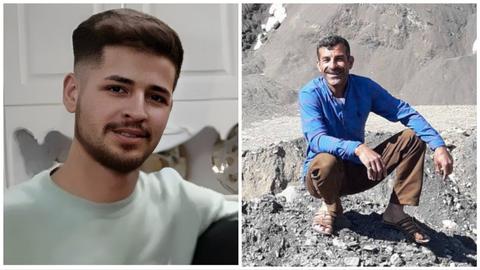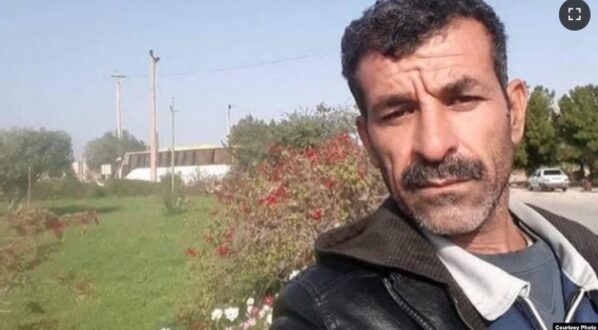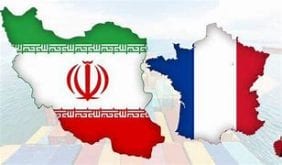Iranwire – It was a rare moment of joy for opponents of capital punishment in Iran when lawyers of Mohammad Ghobadloo and Abbas Daris, two protesters who had been sentenced to death, reported that the Supreme Court of the Islamic Republic has stayed their executions pending a judicial review and a retrial. Many campaigns on social media had called for the repeal of the sentences.

However, this joy was overshadowed by a question: Why have other executions not been stopped?
***
Two Exceptions among Too Many Executions
In recent weeks, the government of the Islamic Republic has increased pressure on civil society and the families seeking justice for their loved ones who had been killed during protests. However, on July 26, unexpected news made Iranians who have been calling for a stop to the execution of protesters happy.
Ghobadloo was sentenced to death in October 2022 by a Revolutionary Court presided by the infamous “Hanging Judge,” Abolghasem Salavati, for allegedly running over members of riot police. One policeman by the name of Farid Karampour was killed and five others were injured. His appeal was rejected and the verdict was upheld by the Supreme Court in December.
But on July 26, Ghobadloo’s lawyer Amir Raeesian tweeted that his death sentence has been overturned by Branch 1 of the Supreme Court and the case would be sent to another branch of the Revolutionary Court for a retrial. He praised the Supreme Court for its decision and also thanked the family of the policeman who had been killed for not demanding an early execution.
Ghobadloo is a young man of 23 who, according to his family and former cellmates, suffers from severe bipolar disorder. In a letter to the head of the Iranian judiciary, 50 psychiatrists and psychologists have asked the judiciary to conduct a “more detailed” psychological study of him.
Meanwhile, the judiciary also granted a retrial to Deris, a member of the Arab minority in Khuzestan province who had been sentenced to death over his participation in the 2019 nationwide protests. He was charged with shooting to death a member of the riot police by the name of Reza Sayadi in the city of Mahshahr.
Earlier in July, his three young sons appealed to the authorities not to carry out the execution.
“We implore for forgiveness and mercy to save our father’s life,” one of the boys said in a video circulated on social media. “His sentencing has already claimed the life of our mother who suffered a fatal stroke. Our father is all we have left.”
In an interview with the Telegram Channel Etemad, Deris’s lawyer Mahmoud Behzadi-Rad cited two reasons behind the decision to stay the execution: The first was that Sayadi’s family does not believe Deris murdered the police officer; Second, experts reported that the policeman had been shot from a distance of 120 meters whereas evidence in the case shows that Deris was 170 meters away from him during the incident.
These two cases stand out as rare exceptions to the behavior of the Islamic Republic since the “Woman, Life, Freedom” protests started in September 2022. On May 19, despite widespread protests and campaigns, Majid Kazemi, 30, Saleh Mir Hashemi, 36, and Saeed Yaghoubi, 37, were executed at dawn in Dastgerd prison in the central city of Isfahan. Authorities claimed the trio was implicated in the death of two members of the Basij paramilitary force and a law enforcement officer during protests in Isfahan in November.
Human rights groups say the three men were deprived of access to lawyers of their choice, subjected to torture and pushed into making false confessions.
Earlier, despite international pressure and appeals, the Islamic Republic executed four other young protesters by the names of Mohsen Shekari, Majid Reza Rahnavard, Mohammad Mehdi Karami and Seyyed Mohammad Hosseini.
A look at political and security-related death sentences issued by the Iranian judiciary in recent years shows that in only a few cases the pressure of public opinion, media and legal campaigns and, sometimes, street protests by opponents of the death penalty succeeded in preventing executions.
One of these rare cases was when the death sentences against three young men arrested during November 2019 protests — Amir Hossein Moradi, Saeed Tamjidi, and Mohammad Rajabi — were reduced to prison time.
In July 2020, after millions of tweets hashtagged “#Do_not_execute,” the Supreme Court overturned the death sentences and sent the cases to the Revolutionary Court for retrial. The death sentences were later reduced to five years in prison and the three were released on bail in the following months.
The Untrustworthy Judiciary
Why do some campaigns to save people from the gallows succeed while others fail?
Hossein Raeesi, a professor of law at University of Carlton in Canada who has defended tens of human rights activists in Iran, tells IranWire that the Islamic Republic’s judiciary is “untrustworthy” and “lacks the necessary independence.”
“It is not a democratic system and it is controlled hierarchically from top to bottom,” he says. “Specifically, Revolutionary Courts cannot be considered independent in any sense of the word. Even if some judges want to be independent, they cannot act independently because, to all intents and purposes, the decisions are made by the security establishment.”
There are different theories as to why some death sentences are carried out while others are not, Raeesi says. One reason is the fear that, with the first anniversary of Mahsa Amini’s death while in police custody approaching, one spark can rekindle protests: “Voices have been raised from inside the regime and by some clergymen who say that these verdicts are wrong. We are near the anniversary of Mahsa Amini’s murder and the government is worried that any provocation can bring people back to the streets. Naturally, the execution of these young people can provide such a provocation, especially since people know about their cases.”
Another reason is that the judiciary is not homogenous, says Raeesi: “There are judges who sometimes act independently. Sometimes, in the absence of the presiding judge in one branch of the Revolutionary Court, his deputy has issued verdicts inconsistent with the wishes of the security establishment.”
As an example, he cites the following case: On November 3, 2022, mourners gathered at a cemetery in Karaj to pay tribute to a 20-year old woman protester, Hadis Najafi, who had been killed by security forces. A member of the paramilitary Basij Organization by the name of Ruhollah Ajamian was killed in clashes with the mourners. Two protesters were hanged and 14 others, including a number of children, were sentenced to prison over Ajamian’s death.
Afterward, says Raeesi, an assistant prosecutor of the Supreme Court proved that the death sentences were wrong and the charges of “corruption on Earth” and “waging war against God” that had been brought against the defendants Mohammad Mehdi Karami and Seyyed Mohammad Hosseini were invalid.
Legal Action Gets Results
Raeesi says there is “no way of measuring how effective” media campaigns have been in stopping executions.
“Campaigns can make a difference because social media are powerful, people have access to the news, learn what Mohammad Ghobadloo’s lawyer has said and whether the verdict has been just or not, but the real work was done by the lawyers,” he says.
In 2015, an amendment to Article 48 of the Islamic Penal Code deprived defendants of their right to be assisted by lawyers of their choice during the pre-trial investigative phase of security cases. During this phase a defendant may only choose attorneys who have been previously approved by the head of the judiciary.
Raeesi says that this amendment violates the constitution. He says the lawyers have access to the file of the case when it goes to trial. Only at that moment can they look at the evidence against their clients and see how valid it is.
Raeesi points out that, in the cases of Ghobadloo and Daris, their lawyers carefully searched the case and found seemingly unimportant details that, in the end, proved the invalidity of the verdict: “Only the lawyer can present a collection of incontrovertible evidence and prevent political and security interference in cases such as these two. You can discover the truth only by carefully gathering evidence, and that is what the lawyers in these two cases did, proving that they couldn’t have committed the crimes they were accused of.”
The Judiciary’s Animosity toward Lawyers
Human rights lawyers who have defended political and civil rights activists, protesters and grieving families of the victims have themselves been repeatedly imprisoned or have had to deal with attempts by security agencies to frame them up. For example, in December 2022, Fereshteh Tabanian, Daris’ lawyer, was charged with “propaganda against the regime” and sentenced to three months in prison because she had given interviews about the case against her client to domestic media.
Raeesi believes that the lawyers’ effectiveness has pushed the judiciary and Revolutionary Courts to deprive political prisoners and prisoners of conscience of their right to be assisted by lawyers of their choice: “Especially in political and security cases in which confessions are extracted by torture and pressure, the lawyer looks at the case under a microscope to find out how the evidence has been obtained and how the charges against the defendant have been brought, and to clarify whether the defendant can be charged with a crime or not.”
“This is why the Islamic Republic tries to prevent lawyers from accessing the case file and wants to bring in its own lawyers into the case. It is successful when it brings its own lawyers but less so when independent lawyers are involved.”
 Shabtabnews In this dark night, I have lost my way – Arise from a corner, oh you the star of guidance.
Shabtabnews In this dark night, I have lost my way – Arise from a corner, oh you the star of guidance.



